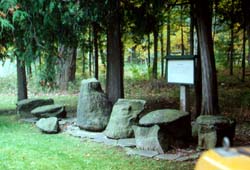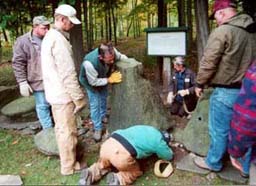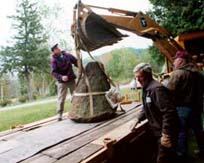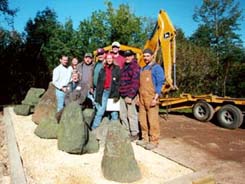FOR IMMEDIATE RELEASE00-49
September
25, 2000
Contact:
Geoff Ryan
(718/595-6600)
Rare
Fossil Trees To Be Moved To New Site In Gilboa
 Nine
370 million year-old fossil trees are being moved to a new site one-half
mile from the overlook at the Gilboa Dam, according to an announcement
by Commissioner Joel A. Miele Sr., P.E., of the New York City Department
of Environmental Protection (DEP), and Kristen V. H. Wyckoff of the
Gilboa Historical Society. Currently located on City-owned property
below the dam on State Route 990V, the rare fossil trees will be loaned
by DEP to the Gilboa Historical Society for a new exhibit and educational
kiosk on land owned by the Town of Gilboa. The move will be a joint
effort of community members and contractors, who are volunteering
their services, as well as staff members from DEP and the Town of
Gilboa. The move is scheduled for Friday, September 29th, weather
permitting, with a rain date set for Friday, October 13th.
Nine
370 million year-old fossil trees are being moved to a new site one-half
mile from the overlook at the Gilboa Dam, according to an announcement
by Commissioner Joel A. Miele Sr., P.E., of the New York City Department
of Environmental Protection (DEP), and Kristen V. H. Wyckoff of the
Gilboa Historical Society. Currently located on City-owned property
below the dam on State Route 990V, the rare fossil trees will be loaned
by DEP to the Gilboa Historical Society for a new exhibit and educational
kiosk on land owned by the Town of Gilboa. The move will be a joint
effort of community members and contractors, who are volunteering
their services, as well as staff members from DEP and the Town of
Gilboa. The move is scheduled for Friday, September 29th, weather
permitting, with a rain date set for Friday, October 13th.
 Commissioner
Miele said, "We are pleased to partner with the Gilboa Historical
Society to provide better access and improve the educational value
of these ancient relics of the Catskill Region's history. We are truly
fortunate that construction workers at the stone quarry for the dam
took an interest in these fossils during their blasting work and made
an effort to carefully remove them as they worked."
Commissioner
Miele said, "We are pleased to partner with the Gilboa Historical
Society to provide better access and improve the educational value
of these ancient relics of the Catskill Region's history. We are truly
fortunate that construction workers at the stone quarry for the dam
took an interest in these fossils during their blasting work and made
an effort to carefully remove them as they worked."
The fossils were uncovered in the early 1920s, during construction
of New York City's Schoharie Reservoir by the Hugh Nawn Contracting
Company, the contractor for the reservoir.  The
fossils, some of the only survivors of their type in the World, are
remnants of Earth's earliest forests. According to Dr. Robert Titus
of SUNY Oneonta, the trees are essentially big ferns with woody stems
whose descendants evolved into cone-bearing, evergreen trees. They
were located along the coast of an inland sea that covered what is
now the southern part of New York and western Pennsylvania. Winifred
Goldring, a New York State paleobotanist who went on to become the
first woman State Paleontologist, analyzed these fossils and ultimately
supervised the construction of the "Gilboa forest restoration"
in the old State Museum in Albany that opened in 1925. The fossils
being moved were part of a 1927 outdoor exhibit near a quarry site
that provided stones for construction of the Gilboa Dam, which impounds
the Schoharie Reservoir. Other fossil trees from the site were sent
to institutions in Europe and South America.
The
fossils, some of the only survivors of their type in the World, are
remnants of Earth's earliest forests. According to Dr. Robert Titus
of SUNY Oneonta, the trees are essentially big ferns with woody stems
whose descendants evolved into cone-bearing, evergreen trees. They
were located along the coast of an inland sea that covered what is
now the southern part of New York and western Pennsylvania. Winifred
Goldring, a New York State paleobotanist who went on to become the
first woman State Paleontologist, analyzed these fossils and ultimately
supervised the construction of the "Gilboa forest restoration"
in the old State Museum in Albany that opened in 1925. The fossils
being moved were part of a 1927 outdoor exhibit near a quarry site
that provided stones for construction of the Gilboa Dam, which impounds
the Schoharie Reservoir. Other fossil trees from the site were sent
to institutions in Europe and South America.
 Ms.
Wyckoff said, "Most people do not realize that these fossils
are world famous among geologists because of the important story they
tell about the earth and the Catskill Region's role in evolution.
The changes that occurred during the Devonian Period brought life
to a profound level of possibility, making life, as we know it, possible.
The exhibit we are preparing will provide an invaluable opportunity
for people of all ages to learn about the natural history and geology
of the Catskill Watershed."
Ms.
Wyckoff said, "Most people do not realize that these fossils
are world famous among geologists because of the important story they
tell about the earth and the Catskill Region's role in evolution.
The changes that occurred during the Devonian Period brought life
to a profound level of possibility, making life, as we know it, possible.
The exhibit we are preparing will provide an invaluable opportunity
for people of all ages to learn about the natural history and geology
of the Catskill Watershed."
 The
project is funded by a $10,000 grant from the "Public Education
Program," which was created under the Watershed Memorandum of
Agreement, funded by New York City, and administered by the Catskill
Watershed Corporation. As part of the grant's "matching funds",
local volunteers will be building an attractive platform for the fossils
and preparing text and illustrations for an informational kiosk and
video. The video will be available to schools and public groups on
a request basis.
The
project is funded by a $10,000 grant from the "Public Education
Program," which was created under the Watershed Memorandum of
Agreement, funded by New York City, and administered by the Catskill
Watershed Corporation. As part of the grant's "matching funds",
local volunteers will be building an attractive platform for the fossils
and preparing text and illustrations for an informational kiosk and
video. The video will be available to schools and public groups on
a request basis.
For more information, please telephone David Barnet, DEP at (845)
340-7573 or Linda Trautman Stratigos, Gilboa Historical Society at
(607) 652-3316.
 Nine
370 million year-old fossil trees are being moved to a new site one-half
mile from the overlook at the Gilboa Dam, according to an announcement
by Commissioner Joel A. Miele Sr., P.E., of the New York City Department
of Environmental Protection (DEP), and Kristen V. H. Wyckoff of the
Gilboa Historical Society. Currently located on City-owned property
below the dam on State Route 990V, the rare fossil trees will be loaned
by DEP to the Gilboa Historical Society for a new exhibit and educational
kiosk on land owned by the Town of Gilboa. The move will be a joint
effort of community members and contractors, who are volunteering
their services, as well as staff members from DEP and the Town of
Gilboa. The move is scheduled for Friday, September 29th, weather
permitting, with a rain date set for Friday, October 13th.
Nine
370 million year-old fossil trees are being moved to a new site one-half
mile from the overlook at the Gilboa Dam, according to an announcement
by Commissioner Joel A. Miele Sr., P.E., of the New York City Department
of Environmental Protection (DEP), and Kristen V. H. Wyckoff of the
Gilboa Historical Society. Currently located on City-owned property
below the dam on State Route 990V, the rare fossil trees will be loaned
by DEP to the Gilboa Historical Society for a new exhibit and educational
kiosk on land owned by the Town of Gilboa. The move will be a joint
effort of community members and contractors, who are volunteering
their services, as well as staff members from DEP and the Town of
Gilboa. The move is scheduled for Friday, September 29th, weather
permitting, with a rain date set for Friday, October 13th.  Commissioner
Miele said, "We are pleased to partner with the Gilboa Historical
Society to provide better access and improve the educational value
of these ancient relics of the Catskill Region's history. We are truly
fortunate that construction workers at the stone quarry for the dam
took an interest in these fossils during their blasting work and made
an effort to carefully remove them as they worked."
Commissioner
Miele said, "We are pleased to partner with the Gilboa Historical
Society to provide better access and improve the educational value
of these ancient relics of the Catskill Region's history. We are truly
fortunate that construction workers at the stone quarry for the dam
took an interest in these fossils during their blasting work and made
an effort to carefully remove them as they worked." The
fossils, some of the only survivors of their type in the World, are
remnants of Earth's earliest forests. According to Dr. Robert Titus
of SUNY Oneonta, the trees are essentially big ferns with woody stems
whose descendants evolved into cone-bearing, evergreen trees. They
were located along the coast of an inland sea that covered what is
now the southern part of New York and western Pennsylvania. Winifred
Goldring, a New York State paleobotanist who went on to become the
first woman State Paleontologist, analyzed these fossils and ultimately
supervised the construction of the "Gilboa forest restoration"
in the old State Museum in Albany that opened in 1925. The fossils
being moved were part of a 1927 outdoor exhibit near a quarry site
that provided stones for construction of the Gilboa Dam, which impounds
the Schoharie Reservoir. Other fossil trees from the site were sent
to institutions in Europe and South America.
The
fossils, some of the only survivors of their type in the World, are
remnants of Earth's earliest forests. According to Dr. Robert Titus
of SUNY Oneonta, the trees are essentially big ferns with woody stems
whose descendants evolved into cone-bearing, evergreen trees. They
were located along the coast of an inland sea that covered what is
now the southern part of New York and western Pennsylvania. Winifred
Goldring, a New York State paleobotanist who went on to become the
first woman State Paleontologist, analyzed these fossils and ultimately
supervised the construction of the "Gilboa forest restoration"
in the old State Museum in Albany that opened in 1925. The fossils
being moved were part of a 1927 outdoor exhibit near a quarry site
that provided stones for construction of the Gilboa Dam, which impounds
the Schoharie Reservoir. Other fossil trees from the site were sent
to institutions in Europe and South America. Ms.
Wyckoff said, "Most people do not realize that these fossils
are world famous among geologists because of the important story they
tell about the earth and the Catskill Region's role in evolution.
The changes that occurred during the Devonian Period brought life
to a profound level of possibility, making life, as we know it, possible.
The exhibit we are preparing will provide an invaluable opportunity
for people of all ages to learn about the natural history and geology
of the Catskill Watershed."
Ms.
Wyckoff said, "Most people do not realize that these fossils
are world famous among geologists because of the important story they
tell about the earth and the Catskill Region's role in evolution.
The changes that occurred during the Devonian Period brought life
to a profound level of possibility, making life, as we know it, possible.
The exhibit we are preparing will provide an invaluable opportunity
for people of all ages to learn about the natural history and geology
of the Catskill Watershed." The
project is funded by a $10,000 grant from the "Public Education
Program," which was created under the Watershed Memorandum of
Agreement, funded by New York City, and administered by the Catskill
Watershed Corporation. As part of the grant's "matching funds",
local volunteers will be building an attractive platform for the fossils
and preparing text and illustrations for an informational kiosk and
video. The video will be available to schools and public groups on
a request basis.
The
project is funded by a $10,000 grant from the "Public Education
Program," which was created under the Watershed Memorandum of
Agreement, funded by New York City, and administered by the Catskill
Watershed Corporation. As part of the grant's "matching funds",
local volunteers will be building an attractive platform for the fossils
and preparing text and illustrations for an informational kiosk and
video. The video will be available to schools and public groups on
a request basis.